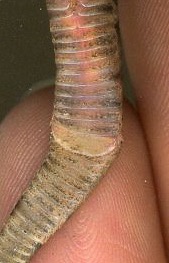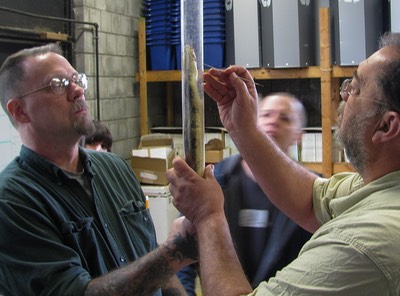
Eastern Ratsnake hatchling
Like all organisms, snakes have external visible structures that are easy to learn and simple to see with modern, close-focusing binoculars.

Barring any damage, all snakes have two eyes (with a dark pupil surrounded by a colorful iris), a pair of nostrils, a bifurcated tongue, enlarged ventral scales, small subcaudals, an anal plate, and a tail tip. Our two venomous snakes share another neat structure — the temperature-sensitive (or loreal) pit organ. Found on each side, between the eye and nostril, it is a large and usually obvious opening. The loreal pit leads to a thermal imaging apparatus, allowing pit vipers (where did they get that name from?) to follow prey or sense other aspects of their environment in darkness (at night, in burrows, and possibly inside winter dens).
Scales entirely cover a snake’s body, providing protection from abrasion, ectoparasites, predators, fungi, water loss, desiccation, and excess humidity. As part of the skin, scales are richly supplied with nerve endings, various glands, muscle fibers, and pigments that give snakes their rich colors and patterns. Scales transform solar radiation into heat that keeps a snake’s body at an optimal temperature during the active season. There may be other functions of scales such as UV shading, raindrop or dew collection (for drinking), locomotion (tree climbing, swimming, crawling), sound production, or more. Snakes are born with all the scales they’ll ever have; as snakes grow, the size of each scale grows, too.
Our snakes in Western Massachusetts are members of the “Advanced Snakes” clade (or group) of reptiles that share a number of external structural similarities. For example, all have large (usually paired) scales on the top of the head (the Timber Rattlesnake has mostly small head scales), wide ventrals, and small (sometimes paired) scales beneath the tail (called subcaudals). The tail begins at the cloaca (the opening for both digestive product removal and reproduction) where the body ends. The cloacal opening is covered by a distinct ventral scale, called the anal plate, which can be a single scale, or divided into two overlapping parts.
Knowing where the body ends and the tail begins enables uniform measurements and size estimates. Herpetologists measure snakes from the tip of the snout to the tip of the tail for a “total length” and from the tip of the snout to the far end of the anal plate (the “snout-vent” length). The different measurements accommodate the fairly frequent observation that a snake may be missing part of its tail (due to predation or accident). A snake’s tail can be very long (as in Ribbonsnakes) or short (as in Hognose); the percentage of tail length to total length, is a useful measure. Also, since male hemipenes are inverted into the tail, males tend to have stouter and longer tails than females. Even when males have a shorter total length, their tails may be proportionally longer than females and they also have more subcaudal scales.
Musk, and other glands found near the base of the tail, are common in most snakes. To discharge musk, a Gartersnake lifts the anal plate and releases an impressive amount that becomes pleasant to most herpetologists—after years of exposure. You, too, may come to enjoy it someday.

Right: Technique to measure and count scales on neonate Timber Rattlesnake using flatbed scanner.
Below: Scan of live neonate Copperhead. A safe and accurate method for counting scales. Note yellow-tipped tail.





